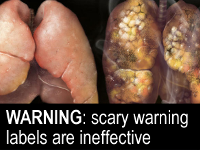
This website collects a number of recent studies about the effectiveness of threatening communication. If you know of more articles on this topic, please contact me so I can add them. I'll add all articles that are Open Access (either through the Gold Road or the Green Road) and have adequate methodology given their research questions and conclusions. The statements below are each supported by one or more scientific articles - all articles are open access. You can click their titles, below each statement, to view the articles.
The videocast accompanying the special issue on fear appeals from the International Journal of Psychology is here.
In early 2018, a controversial paper was published that aimed to summarize the research on fear appeals as well as the history of this research. It sparked a lively debate, and seven commentaries were published. In the rejoinder to those commentaries, the original authors sought to identify common ground and move towards optimally effective behavior change interventions. One example is the proposal to use the health communication space available on tobacco packaging, which is currently in use for warning labels that focus on threatening communication, for employing more powerful messages. Links to the papers in this debate are provided here.
- Ignoring theory and misinterpreting evidence: the false belief in fear appeals
- Misinterpreting theory and ignoring evidence: fear appeals can actually work: a comment on Kok et al. (2018)
- Pictorial cigarette pack warnings increase quitting: a comment on Kok et al.
- What constitutes evidence that fear appeals have positive effects on health behaviour? Commentary on Kok, Peters, Kessels, ten Hoor, and Ruiter (2018)
- Ignoring theory and evidence: commentary on Kok et al. (2018)
- Don’t throw the baby out with the bath water: Commentary on Kok, Peters, Kessels, ten Hoor, and Ruiter (2018)
- A (Re)defining moment for fear appeals: a comment on Kok et al. (2018)
- Investigating belief falsehood. Fear appeals do change behaviour in experimental laboratory studies. A commentary on Kok et al. (2018)
- Towards Consensus on Fear Appeals: A rejoinder to the commentaries on Kok, Peters, Kessels, ten Hoor & Ruiter (2018)
- The extensive supplemental file for "Towards consensus on fear appeals"
The Extended Parallel Process model describes how threatening communication is processed. This is a visualisation of this model:

- Our presentation on this project at EHPS 2012 in Prague.
- Threatening communication: diffusing the scientific evidence on fear appeal effectiveness among intervention developers, policy makers, politicians, scientists and advertising professionals (pre-publication version, only accessible until the manuscript gets published)
- The supplementary materials for the evaluation of this intervention
